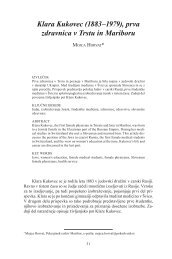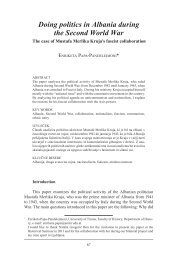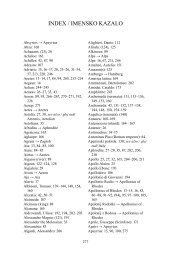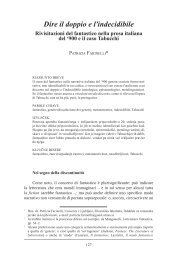The Invention of Modern Aesthetics: From Leibniz to Kant
The Invention of Modern Aesthetics: From Leibniz to Kant
The Invention of Modern Aesthetics: From Leibniz to Kant
Create successful ePaper yourself
Turn your PDF publications into a flip-book with our unique Google optimized e-Paper software.
<strong>The</strong> <strong>Invention</strong> <strong>of</strong> <strong>Modern</strong> <strong>Aesthetics</strong>: <strong>From</strong> <strong>Leibniz</strong> <strong>to</strong> <strong>Kant</strong><br />
distinctions between clear and confused ideas and perceptions and their<br />
relationship <strong>to</strong> what <strong>Leibniz</strong> regarded as distinct ideas before moving<br />
on in the third section <strong>to</strong> Baumgarten’s foundation <strong>of</strong> aesthetics.<br />
<strong>Leibniz</strong>’s analysis <strong>of</strong> obscure, clear and distinct ideas and concepts<br />
is a further development and modiication <strong>of</strong> a similar distinction<br />
we ind in Descartes’ philosophy. In his most comprehensive work,<br />
the Principia philosophiae (1644), Descartes distinguished between<br />
clear ideas and distinct ideas, although the phrase »clear and distinct<br />
ideas« occurs frequently in his other writings and is even employed<br />
as a criterion <strong>of</strong> truth. Something is clear, he says, »which is present<br />
and apparent <strong>to</strong> an attentive mind«, and something is distinct »which<br />
is so precise and different from all other objects that it contains within<br />
itself nothing but what is clear«. 10 For a judgment <strong>to</strong> be incontrovertible,<br />
Descartes claims, it must be based on ideas which are both clear<br />
and distinct. It is possible <strong>to</strong> have clear ideas (perceptions) <strong>of</strong> pain, for<br />
example, without any real knowledge <strong>of</strong> the causes <strong>of</strong> the pain. 11 Similarly<br />
we can have clear ideas (perceptions) <strong>of</strong> colours without any real<br />
(distinct) knowledge <strong>of</strong> the causes <strong>of</strong> our perceptions. 12 <strong>Leibniz</strong>’s discussion<br />
<strong>of</strong> clear and distinct ideas, is, however <strong>of</strong> greater importance<br />
for Baumgarten’s endeavour <strong>to</strong> establish aesthetics as an au<strong>to</strong>nomous<br />
philosophical discipline. In his short treatise »Meditationes de cognitione,<br />
veritate et ideis« (1684) <strong>Leibniz</strong> distinguishes between different<br />
kinds <strong>of</strong> and different degrees <strong>of</strong> knowledge, »[k]nowledge«, he<br />
says, »is either obscure or clear; clear knowledge is either confused<br />
or distinct; distinct knowledge is either inadequate or adequate, and<br />
also either symbolic or intuitive«, the most perfect knowledge being<br />
both adequate and intuitive. 13 Knowledge is obscure, he contends,<br />
when it does »not sufice for recognizing the thing represented, as<br />
when I merely remember some lower or animal which I have once<br />
seen but not well enough <strong>to</strong> recognize it when it is placed before me<br />
and <strong>to</strong> distinguish it from similar ones«. 14 When we recognize a thing<br />
10<br />
René Descartes, <strong>The</strong> Essential Descartes, 1976, ed. with an Introduction by Margaret<br />
D. Wilson (New York: Meridian, 1993), § 45, pp. 320–321.<br />
11<br />
»When, for instance, a severe pain is felt, the perception <strong>of</strong> this pain may be very<br />
clear, and yet for all that not distinct, because it is usually confused by the sufferers<br />
with the obscure judgment that they form upon its nature«, Descartes says (ibid.,<br />
§ 46, p. 321). When we were young we »knew nothing distinctly, although [our<br />
minds] perceived much suficiently clearly« (ibid., § 47, p. 321).<br />
12<br />
Ibid., § 70, p. 332. Having distinct knowledge <strong>of</strong> colours presumably presupposes<br />
knowledge <strong>of</strong> the laws <strong>of</strong> the refraction <strong>of</strong> light and the wavelengths <strong>of</strong> particular<br />
colours, for example that red has the wavelengt <strong>of</strong> 780–622 nanometers.<br />
13<br />
Gottfried Wilhelm <strong>Leibniz</strong>, »Meditations on Knowledge, Truth, and Ideas«, in G. W.<br />
<strong>Leibniz</strong>, Philosophical Papers and Letters, A Selection translated and edited with an<br />
introduction by Leroy E. Loemker, 2nd ed. (Dordrecht: Reidel, 1969), p. 291.<br />
14<br />
Ibid.<br />
137











